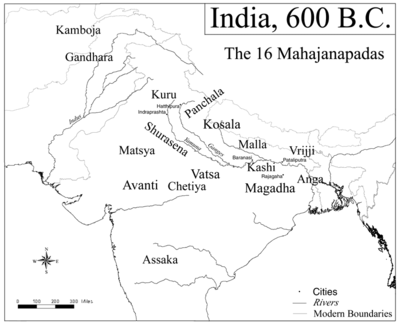Surasena

| Mahajanapada
| |
| Anga | |
| Assaka (Asmaka) | |
| Avanti | |
| Chedi | |
| Gandhara | |
| Kashi | |
| Kamboja | |
| Kosala | |
| Kuru | |
| Magadha | |
| Malla (Mallarashtra) | |
| Machcha (Matsya) | |
| Panchala | |
| Surasena | |
| Vriji | |
| Vatsa (Vamsa) | |
Surasena (or Sourasena) (Sanskrit: शूरसेन, Śūrasena) was an ancient Indian region corresponding to the present-day Braj region in Uttar Pradesh. According to the Buddhist text Anguttara Nikaya, it is mentioned in the Ramayana as an earlier Janapada state from at least 1000 BCE. Surasena was one of the solasa (sixteen) Mahajanapadas (powerful realms) in the 7th century BCE.[1] The ancient Greek writers refer to the region as Sourasenoi and mention its capital as Methora.[2]
Etymology
There are several traditions regarding the etymology of its name. According to one tradition, it was derived from a famed Yadava king, Surasena, while others see it as an extension of Surabhir (Abhira) or Ahir.[3][4] It was the sacred land of Lord Krishna in which he was born, raised, and ruled.[5]
History
The Mahabharata and the Puranas refer to the rulers of the Mathura region as the Yadus or Yadavas, divided into a number of septs, which include the Vrishnis.[6][7] The Buddhist texts refer to Avantiputta, the king of the Surasenas in the time of Maha Kachchana, one of the chief disciples of Gautama Buddha, who spread Buddhism in the Mathura region.[6]
Its capital, Mathura, was situated on the bank of the river Yamuna, presently a sacred place for the Hindus. The ancient Greek writers mention another city, named Cleisobora, in this region.[2]
See also
References
- ↑ Raychaudhuri 1972, p. 85
- 1 2 Raychaudhuri 1972, p. 124
- ↑ Shalomim Y. Halahawi (2007). The Way! the Prophetic Messianic Voice to the Path of the Edenic Kingdom Redemption. Lulu.com, 2007 ISBN 1430308168, 9781430308164. p. 315. ISBN 9781430308164.
- ↑ New Indian Antiquary (1943). New Indian Antiquary, Volumes 5-6. Karnatak Publishing House., Original from the University of California. p. 127.
- ↑ Royal Asiatic Society of Great Britain and Ireland (1899). Journal of the Royal Asiatic Society of Great Britain and Ireland. Cambridge University Press for the Royal Asiatic Society, Original from the University of Michigan. p. 322.
- 1 2 Raychaudhuri 1972, p. 128
- ↑ Singh 2008, p. 264
Sources
- Raychaudhuri, H.C. (1972), Political History of Ancient India: From the Accession of Parikshit to the Extinction of the Gupta Dynasty, Calcutta: University of Calcutta.
- Singh, Upinder (2008), A History of Ancient and Early Medieval India: From the Stone Age to the 12th Century, Delhi: Pearson Education, ISBN 978-81-317-1677-9.
